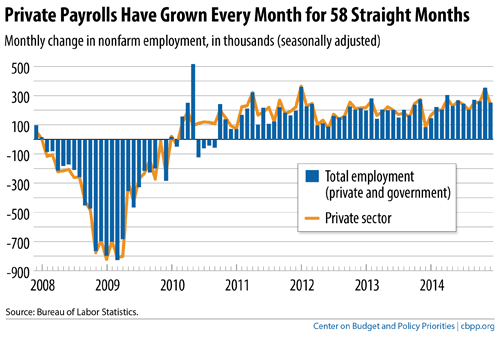Today's jobs report shows a labor market that strengthened significantly in 2014, but one that still bears scars from the Great Recession and subsequent federal budget cuts and other austerity policies that perpetuated a severe jobs slump even as the economy and business profits began to recover.
On the positive side, in 2014, the unemployment rate fell from 6.7 percent in December 2013 to 5.6 percent in December 2014, and employers added an average of 246,000 jobs a month (see chart). That's the largest 12-month gain in the recovery. At the same time, too many people who want a job haven't found one, especially among the long-term unemployed. Although unemployment fell sharply in December, for example, the labor force actually shrank as more people dropped out than found jobs.
Private-sector employers have added jobs for 58 straight months, but for much of that period government job losses held down overall job creation. Last year, the huge job losses from the recession were finally erased and government employment also began to grow modestly. Restoring payroll employment to its pre-recession level was a milestone on the way to a full jobs recovery, but population growth over the past several years means the potential labor force is now larger. To restore full employment, job creation must continue to outpace population growth.
The potential labor force includes not only people who are actively looking for work (the unemployed) but also people who want to work but are not actively looking because they think jobs are hard to find. The number of such people -- who are not counted in the labor force -- rose sharply in the recession and subsequent jobs slump, as did the number of people who want to work full time but can only find part-time jobs. Similarly, the number of long-term unemployed (jobless for 27 weeks or longer), who face greater problems finding work than those who have been unemployed for a shorter period -- in part because of employer discrimination against the long-term unemployed -- rose sharply.
All of these indicators of labor market "slack" (people who are not working but want to be or people who want to work full time but can only find part-time jobs) fell in 2014. Nevertheless, they remain abnormally high. In particular, the share of the population with a job remains near its recession low. That's why we need continued strong job creation to restore normal labor market conditions.
Policymakers played an important role in preventing the economy from falling into an even deeper hole in late 2008 and early 2009 when they enacted financial stabilization measures, including TARP, and fiscal stimulus measures, especially the American Recovery and Reinvestment Act. Subsequently, however, their misplaced emphasis on immediate deficit-reduction rather than additional temporary stimulus slowed the recovery. The new Congress should recognize that the job market improvements in 2014 occurred in spite of austerity, not because of it.
About the December Jobs Report
Employers reported strong payroll job growth in December. In the separate household survey, the unemployment rate fell to 5.6 percent, but much of the drop in unemployment reflected lower labor force participation rather than an increase in the share of the population with a job.
- Private and government payrolls combined rose by 252,000 jobs in December and the Bureau of Labor Statistics revised job growth in the previous two months upward by a total of 50,000 jobs. Private employers added 240,000 jobs in December, while overall government employment rose by 12,000. Federal government employment rose by 1,000, state government by 7,000, and local government by 4,000. In 2014, federal government employment fell by 17,000 while state government rose by 21,000 and local government rose by 87,000, for a net increase of 91,000 government jobs.
•This is the 58th straight month of private-sector job creation, with payrolls growing by 11.2 million jobs (a pace of 193,000 jobs a month) since February 2010; total nonfarm employment (private plus government jobs) has grown by 10.7 million jobs over the same period, or 184,000 a month. Total government jobs fell by 523,000 over this period, dominated by a loss of 309,000 local government jobs. As noted, however, local government employment grew by 87,000 in 2014. The job losses incurred in the Great Recession have been erased. There are now 2.4 million more jobs on private payrolls and 2.0 million more jobs on total payrolls than at the start of the recession in December 2007. Because the working-age population has grown since then, however, the number of jobs remains well short of what is needed to restore full employment. Employers have expanded their payrolls at a 246,000-a-month pace this year, and such growth must continue to restore normal labor market conditions in a reasonable period of time. Average hourly earnings on nonfarm payrolls fell by 5 cents in December to24.57. Over the last 12 months they have risen 1.7 percent. For production and non-supervisory workers, average hourly earnings fell 6 cents to20.68, or 1.6 percent higher than a year earlier. The unemployment rate fell to 5.6 percent in December, and 8.7 million people were unemployed. The unemployment rate was 4.8 percent for whites (0.4 percentage points higher than at the start of the recession), 10.4 percent for African Americans (1.4 percentage points higher than at the start of the recession), and 6.5 percent for Hispanics or Latinos (0.2 percentage points higher than at the start of the recession). The recession drove many people out of the labor force, and the ongoing lack of job opportunities has kept many potential jobseekers on the sidelines and not counted in the official unemployment rate. In December, the number of unemployed fell by 383,000 but the number of people with a job rose by just 111,000. The difference was a reduction in the labor force of 273,000. These data come from a separate survey from the data on payroll employment and typically show much greater volatility month-to-month. The labor force participation rate (the share of the population aged 16 and over in the labor force) edged down to 62.7 percent in December, about the same as the 62.8 percent a year earlier. The sharp decline in labor force participation during the recovery appears over, but prior to recent years, the labor force participation rate hasn't been this low since the 1970s. December's rate is among the lowest since 1978. The share of the population with a job, which plummeted in the recession from 62.7 percent in December 2007 to levels last seen in the mid-1980s and has remained below 60 percent since early 2009, remained 59.2 percent in December. It was 58.6 percent a year ago. The Labor Department's most comprehensive alternative unemployment rate measure -- which includes people who want to work but are discouraged from looking (those marginally attached to the labor force) and people working part time because they can't find full-time jobs -- edged down to 11.2 percent in December. That's well down from its all-time high of 17.2 percent in April 2010 (in data that go back to 1994) but still 2.4 percentage points higher than at the start of the recession. By that measure, about 18 million people are unemployed or underemployed. The rate was 13.1 percent a year ago (about 21 million people). Long-term unemployment remains a significant concern. More than three in ten (31.9 percent) of the 8.7 million people who are unemployed -- 2.8 million people -- have been looking for work for 27 weeks or longer. These long-term unemployed represent 1.8 percent of the labor force. These figures were 37.3 percent and 2.5 percent a year ago. Before this recession, the previous highs for these statistics over the past six decades were 26.0 percent and 2.6 percent, respectively, in June 1983, early in the recovery from the 1981-82 recession. A year after peaking at 2.6 percent, however, the long-term unemployment rate had dropped to 1.4 percent, well below the current rate.Support HuffPost
Our 2024 Coverage Needs You
Your Loyalty Means The World To Us
At HuffPost, we believe that everyone needs high-quality journalism, but we understand that not everyone can afford to pay for expensive news subscriptions. That is why we are committed to providing deeply reported, carefully fact-checked news that is freely accessible to everyone.
Whether you come to HuffPost for updates on the 2024 presidential race, hard-hitting investigations into critical issues facing our country today, or trending stories that make you laugh, we appreciate you. The truth is, news costs money to produce, and we are proud that we have never put our stories behind an expensive paywall.
Would you join us to help keep our stories free for all? Your contribution of as little as $2 will go a long way.
Can't afford to donate? Support HuffPost by creating a free account and log in while you read.
As Americans head to the polls in 2024, the very future of our country is at stake. At HuffPost, we believe that a free press is critical to creating well-informed voters. That's why our journalism is free for everyone, even though other newsrooms retreat behind expensive paywalls.
Our journalists will continue to cover the twists and turns during this historic presidential election. With your help, we'll bring you hard-hitting investigations, well-researched analysis and timely takes you can't find elsewhere. Reporting in this current political climate is a responsibility we do not take lightly, and we thank you for your support.
Contribute as little as $2 to keep our news free for all.
Can't afford to donate? Support HuffPost by creating a free account and log in while you read.
Dear HuffPost Reader
Thank you for your past contribution to HuffPost. We are sincerely grateful for readers like you who help us ensure that we can keep our journalism free for everyone.
The stakes are high this year, and our 2024 coverage could use continued support. Would you consider becoming a regular HuffPost contributor?
Dear HuffPost Reader
Thank you for your past contribution to HuffPost. We are sincerely grateful for readers like you who help us ensure that we can keep our journalism free for everyone.
The stakes are high this year, and our 2024 coverage could use continued support. If circumstances have changed since you last contributed, we hope you’ll consider contributing to HuffPost once more.
Already contributed? Log in to hide these messages.


